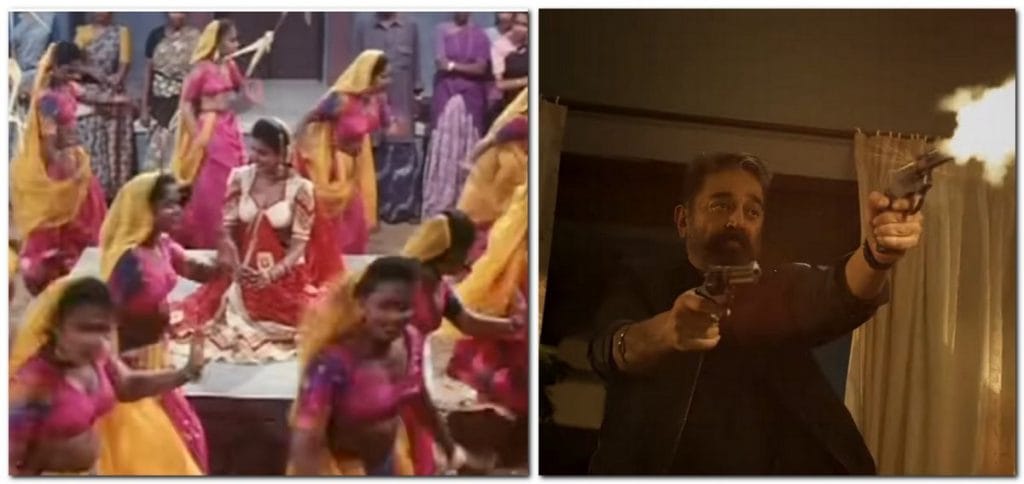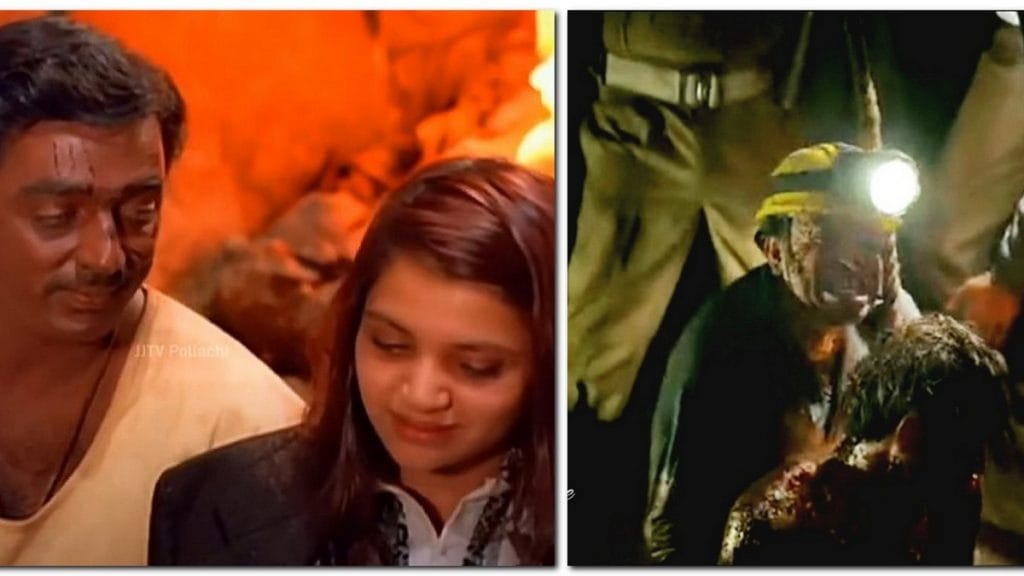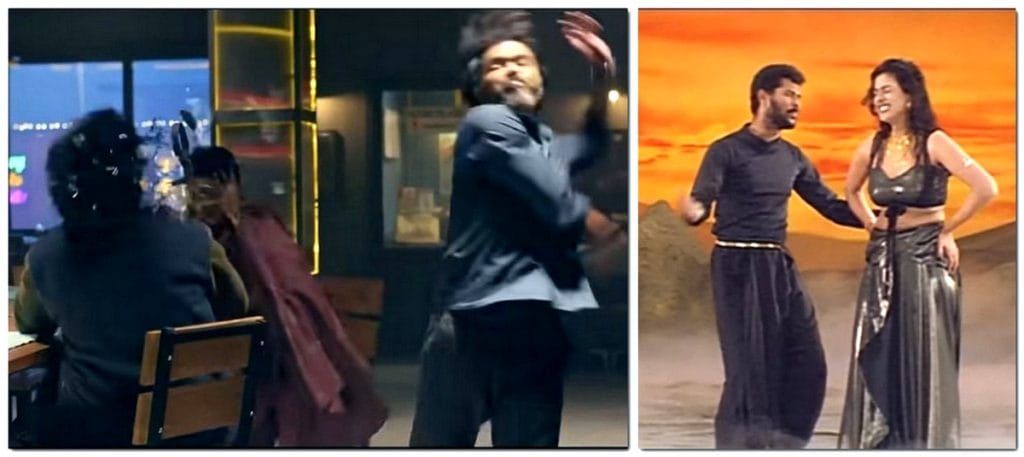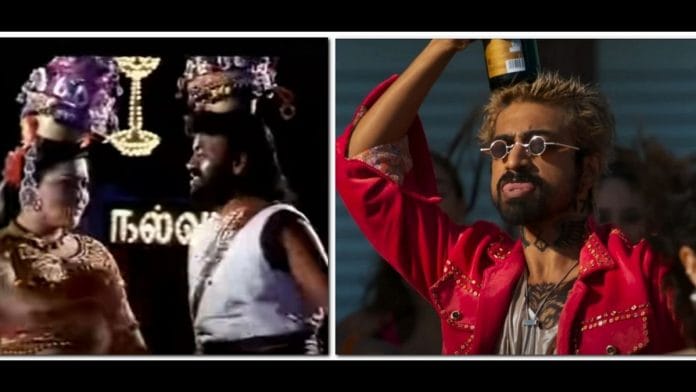Chennai: As the pulsating beats of the song Oththa Roova from the 1996 Tamil film Nattupura Pattu shook a 70mm theatre in Chennai, the audience erupted in nostalgic cheers and whistles. But this wasn’t a re-release. It was a scene from the latest Ajith starrer Good Bad Ugly, where the nearly 30-year-old song was used to introduce one of the villains.
Old hits have long featured in Tamil films, usually to evoke a certain era on screen. But in the last four or five years, these blasts from the past often arrive without rhyme or reason. Now, the trend has been beaten to a pulp, turning into a gratuitous mash-up of retro songs. And more and more Tamil moviegoers are saying they feel scammed.
What began with Aasai Adhigam Vechu in Kaithi (2019), and then went on to become a big rage with Kanmani Anbodu Kadhalan in Manjummel Boys (2024), is now an exhausted fad.
But it still gets social media virality. Current Tamil movie directors are making smart use of the wealth of Tamil music, sometimes using old songs unchanged, sometimes remixing and modernising them.
“A lot of classics, especially those of Ilaiyaraaja from the 1980s and 1990s, are now used so wisely. Rehashing the old songs and giving it to the younger generation gives a new lease of life to retro songs,” said sound engineer Nachi.
But for some, it calls attention to a larger crisis—the lack of creative imagination in the Tamil film industry.
“Everything is just a replica of the retro songs or just reusing the same old songs in new movies to evoke emotions,” film critic Sana said. “How are the present-day music directors going to bring in an emotion with their own new compositions?”
Also Read: Hyderabad’s Annapurna Studios is India’s high-tech film hub. A 50-yr Nagarjuna family legacy
Fresh meanings, millions of views
When protagonist Azhagar from Subramaniapuram (2008) listens to Ilaiyaraaja’s Siru Ponmani Asaiyum from Kallukkul Eeram (1980) on the radio, there’s a reason for it. The scene is a flashback to the 1980s, and the song firmly anchors it in that era. Now, though, retro is more random.
One of the first Tamil films to break from this kind of period setting and use a retro song out of context—such as in the middle of a serious scene or fight—was Lokesh Kanagaraj’s Kaithi (2019), starring Karthi.
In this film, the peppy Aasai Adhigam Vechu from Marupadiyum (1993) plays during the climax fight scene as the antagonist goes on the attack with a sickle.
However, in a ‘masterclass’ for the YouTube channel Neelam Social, Kanagaraj said that his inspiration for using old songs came from Oomai Vizhigal, a 1986 thriller.
“During one of the fight scenes on the road, there were folk artists there and Arun Pandian (who plays one of the characters) would drop a one-rupee coin to them and ask them to play. They would start playing the music and the fight scene was composed with it… This changed how I watched films and stunts thereafter,” Kanagaraj said.
While filmmakers say retro songs bring a different energy to modern movies, film critic and scriptwriter Ashameera Aiyappan says it’s an extension of the social media trend of using old tracks to signal a mood.
“We all might have seen the reels and shorts, where people use classic songs for current scenarios—even if they are completely irrelevant to the scene where the song was originally used,” Aiyappan told ThePrint. “Even some Hollywood movie scenes have been edited with Ilaiyaraaja sir’s songs or background music, and it gained traction.”
Since Kaithi, more than a dozen Tamil films have incorporated retro songs. Jailer (2023), starring Rajinikanth and directed by Nelson Dilipkumar, featured Taal Se Taal from Taal (1999) and Kannodu Kanbathellam from Jeans (1998). Fight Club (2023), starring Vijayakumar, used En Jodi Manjakuruvi from Vikram (1986), while Lubber Pandhu (2023), with Gethu Dinesh and Haris Kalyan, tapped Nee Pottu Vecha Thanga Kudam from Ponmanaselvan (1989).

This year, Good Bad Ugly, or just GBU, took it even further by using as many as eight retro songs—likely the highest count yet.
Aiyappan says it’s now a marketing tool of sorts to target multiple generations all at once.
“While the older generation connects with retro songs and feels nostalgic, the younger generation picks up a few rhythms or lines for reels or shorts on their social media accounts. This way, it appeals to both older and younger generations,” she said.
Influence of retro songs
The trend of old Tamil songs being transplanted into new contexts has rippled into other industries too.
For instance, Kanmani Anbodu Kadhalan, the iconic love song from Gunaa (1991), sung by Kamal Haasan and S Janaki and composed by Ilaiyaraaja, was once a go-to romantic track across South India. But in the Malayalam hit Manjummel Boys, the song took on a new meaning.
In the film, a group of friends gets trapped inside the Guna Caves in Kodaikanal. As they attempt a desperate rescue to save their friend Subash, Kanmani Anbodu plays in the background, amplifying the emotional weight of the moment.

Director Chidambaram later said in Chennai that the film got more attention in Tamil Nadu than in Kerala. He also said the song was essential to the moment, as it perfectly captured the bond between friends.
Many of these old tracks are hitting millions of views on YouTube after being used in new movies, claimed the Chennai-based manager of a music label, who did not want to be named.
For instance, Karu Karu Karupayi from Eazhaiyin Sirippil (2000) crossed 40 million views on the Think Tapes YouTube channel, where it was uploaded a year ago. After the song was used during a fight sequence in the Vijay starrer Leo (2024), the picturisation from the film was also uploaded on the channel, reaching about 57 million views in just one year.

Controversies over copyright
Whether classics cross into Malayalam films or take on new meaning altogether, many share a common trait: they were composed by Ilaiyaraaja.
And when it comes to using retro hits, there’s always one more ingredient in the mix — copyright battles. Ilaiyaraaja, for one, doesn’t hesitate to take legal action when his songs are used without consent.

Last year, he sent a legal notice to the producers of Manjummel Boys for “unlawfully” using Kanmani Anbodu. A legal notice was also issued to Kanagaraj for using Va Va Pakkam Va in the teaser of Coolie, starring Rajinikanth, the composer’s long-time friend. This year, Ilaiyaraaja reportedly sought Rs 5 crore from the producers of GBU for using three of his songs without authorisation.
In some cases, though, Ilaiyaraaja has generously permitted the use of re-recorded songs without seeking compensation—as in Vattara Vazhakku (2023), where he reportedly allowed the makers to use two of his re-recorded songs since the director had a limited budget.
Ilaiyaraaja’s lawyer told ThePrint the legal wrangling often comes from misunderstandings about copyright laws.
“The makers of the movie think that they are entitled to use the song after getting rights from the music labels. But, the Copyright Act, 1957 and 2012 amendment has given the right to get royalty for the composer,” said lawyer Saravanan Annadurai, who represents Ilaiyaraaja in several copyright cases.
But there are also bigger questions about creativity.
Also Read: Is Chennai’s Margazhi Carnatic fest losing sheen? Empty halls, ageing fans, unpaid artists
Not enough future classics?
With old classics ruling the roost, some fear today’s films aren’t leaving behind enough timeless songs.
“Although retro has become part of the film industry, I’m also wondering about the value of songs composed today,” said Aiyappan. “These songs should also have a classic quality so that they could be used 30 years later. But we hardly see any such songs in recent years.”
Sana, who recently watched GBU in a theatre, left dejected by the lack of memorable original tracks.
“I have listened to those retro songs some 1,000 times even before they were used in the movie. But I don’t think I could listen to the original numbers from the movie even a second time,” she said.
Sound engineer Nachi, however, said today’s composers were still trying to produce good original numbers.
“The original numbers with re-listening value may be less. Still, they are trying their best to stay in the industry and entertain the audience for the next few decades,” he added.
(Edited by Asavari Singh)






